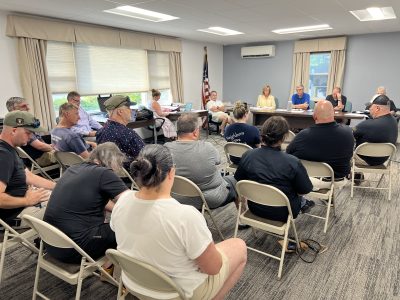New Castle Fire District Grilled Over Finances for Expansion Project
News Based on facts, either observed and verified directly by the reporter, or reported and verified from knowledgeable sources.

Volunteer firefighters confronted the New Castle Board of Fire Commissioners last week, airing their frustrations and demanding to know the status of the district’s delayed $15.2 million firehouse expansion and modernization project.
About 25 members of the Chappaqua Fire Department filled the firehouse conference room last Monday to also lodge objections about the commissioners’ lack of communication regarding the project and what has been seen as secretiveness about district finances.
The commissioners had been poised to vote to accept project bids at the July 8 meeting, but after about two hours, the vote was postponed until this week.
The New Castle Fire District No. 1 has until the end of this week to formally accept bids on the project. If it misses the deadline for the public bidding process, the district must restart that process, although the board was expected to accept the bids at its July 15 meeting.
Commissioners were cautioned by the project’s management team that waiting would likely result in higher costs.
Last year voters approved the $15.2 million referendum to modernize and expand the firehouse at 491 King St. in Chappaqua that was built in 1954 and expanded to its current 17,000-square-foot footprint in 1979. Because the current firehouse is too small to fit modern firefighting apparatus, the plan adds a 13,000-square-foot addition with three new and larger bays.
Prior to the April 2023 vote, commissioners decided to hold down costs by postponing the full build-out of the second floor, which was estimated to cost an additional $1.95 million, according to construction manager Kevin Sawyer of Triton Construction Management, who attended last week’s meeting.
Fire Chief Paul Eiden urged the board against compromising the project, which was also designed to protect the 60 volunteer firefighters from dangerous carcinogens often released in a fire or from fumes emitted during a serious car accident. Currently a washing machine that is too small and takes two cycles to fully decontaminate gear is used after a fire. If a firefighter’s gear can’t be fully decontaminated, there is the risk of transporting remnants of hazardous substances home.
“You understand where the membership is coming from,” Eiden told the board. “We want to make sure that what will be completed in two years, or however long it takes, is a completed structure that has all the health and wellness and safety features for the members.”
Eiden reminded the board that there are already department members suffering from cancer and that it was critical to prevent more of them from getting sick.
“Whatever we can do to avoid that for anyone else going forward should be your number one priority,” he said.
Concerns raised last week about how the district has handled its finances reflected a growing mistrust between firefighters and the board.
Chairman Dwight Smith attempted to allay those concerns, explaining that the district had sufficient funds to cover the project’s cost. In late May, commissioners revealed that the project exceeded budget by about $500,000.
“We have more money that’s available to us,” Smith said. “We have multiple millions of dollars and $1.5 million in-house and in our capital reserves. We have approximately the same amount in capital reserves for trucks. And that’s not all of our accounts.”
Smith noted that a recent conference call with the fire district’s attorney, the attorney representing the district for the project and its financial advisers confirmed that the money on hand in the district’s accounts could be available to help pay for the project. Accessing those additional funds, however, would be subject to a permissive referendum by district residents, whereby a valid petition submitted with a requisite number of signatures would trigger a vote.
“We can use this money for the project including the overage that we have encountered,” Smith said.
But Commissioner Nancy Zezze said she hadn’t seen any bank statements since February.
“I can’t imagine that those accounts have grown by a million-plus of dollars,” she said. “I don’t believe that money is available to finish the first and second floors.”
Zezze said she was concerned money would be pulled from various capital reserves, which are earmarked for other expenses.
“It’s not fair to say that we have money to cover the cost and the expenses necessary to build out the second floor,” Zezze said.
Smith said because the district has only a part-time treasurer it was difficult to access up-to-date financial records.
At a previous meeting, Smith had said the district owned a piece of property used for storing department equipment, which would be put up for sale. But Lynn Weinig, the district’s special counsel, said the department couldn’t factor in proceeds from the potential property sale because the timeline for securing a buyer and completing the sale is unknown.
Commissioners had previously discussed selling the old Senter Street firehouse, which houses a vintage fire truck and other district property.
Eyebrows were raised after Sawyer previously commented that the contractor with the lowest bid wouldn’t be his first choice, an issue Eiden also brought up.
“There’s been complaints from people that worked with this contractor in the past,” Eiden said. “Is that cause enough to spend an extra $50,000 and go with the next highest bidder so we have this comfort level?”
Sawyer said because the new firehouse was a public project, commissioners had to abide by general municipal law, which required the hiring of the lowest responsible bidder.
“They are not the best and they’re not the worst and we’ve worked with them before with firehouses,” Sawyer said of the contractor. “We checked their references, they provided a qualification statement, checked if there were any outstanding lawsuits or issues associated with any public works projects and they didn’t have any of that. We are very limited in saying they are a non-responsive bidder.”
Sawyer assured firefighters that Triton’s job was to oversee and manage the project.
“We will have a representative on site every day when work is being done,” he said.
Despite the tension, Eiden said later last week that last week’s meeting ended on a positive note.
“A number of members in the department who have a business background will come back with suggestions on how to utilize current funding the district may have to finish the second floor and to make sure the funds don’t impede the ability to replace firefighting apparatus,” Eiden said.
“In the last 48 hours communication with the board has improved drastically,” he added. “I’m cautiously optimistic.”
The July 15 Board of Commissioners meeting is scheduled for 6:30 p.m. at the King Street firehouse.

Abby is a seasoned journalist who has been covering news and feature stories in the region for decades. Since The Examiner’s launch in 2007, she has reported extensively on a broad range of community issues. Read more from Abby’s editor-author bio here. Read Abbys’s archived work here: https://www.theexaminernews.com/author/ab-lub2019/
